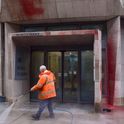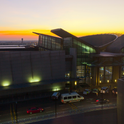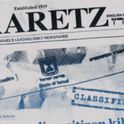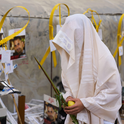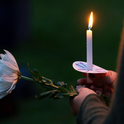In the gardens of Turquoise Mountain’s outlet in Amman, Jordan, I sat down for coffee with Ryan Sturgill, a softly spoken American former banker who spent six years in Gaza funding and developing Palestinian tech enterprises. Now, among other things, he helps exploit weaknesses in the Egyptian and Israeli phone networks to provide the internet to Palestinians in Gaza. But the first note I made from our meeting wasn’t about his record in helping Palestinians. It was a figure he said he’d heard two days before—39,000.
I thought I misheard and asked him to repeat it. Thirty-nine thousand is the number of children who have lost one or both parents in the last 19 months in Gaza, which is the equivalent of the whole population of Ramsgate or, if you like, Monaco. According to the Palestinian statistics authority, around 17,000 of these have no parents. There are tent villages entirely consisting of children who have no one in the world. The mind reels at the scale of the need, of the trauma, grief and bewilderment of these children. During my time in Jordan the figure haunted all my interviews and conversations, because, sooner or later, someone brought it up. It would be followed by a wordless shake of the head at the barbarity taking place so little distance from Jordan. You sensed the deeply felt impotence of an entire population, three million of whom are Palestinian.
Sturgill, who works as an advisor across the Middle East and North Africa with the CrossBoundary Group, an investment firm, set up the first coding academy in Gaza, and moved to Jordan after his second son was born. He suggested that this might be the first genocide to be livestreamed. There’s not a lot of film escaping the enclave in real time, but he’s right that no one can be in any doubt about what’s happening in Gaza right now. During the genocidal atrocities in Kampuchea, Rwanda and Bosnia there wasn’t that kind of immediate awareness—but today, there is no excuse for not knowing. Thirty years ago, I followed the trail blazed by the American reporter David Rohde, who discovered evidence of the massacre by Serbs of more than 7,500 Muslim men and boys at Srebrenica, and began a series of reporting trips to the Republika Srpska in Bosnia and a campaign in the now defunct Independent on Sunday. I remember how hard it was to increase awareness of what had happened. Now, of course, people know everything, unless they turn away.
In Jordan, I wasn’t surprised to find that most people were familiar with the numbers of dead (at least 62,000, including 17,500 children), injured (at least 115,588), missing (14,000) and displaced (two million). There are bigger estimates for each category yet people like the Doctors Without Borders head of mission in Amman, Cyril Cappai, are wary of overstatement that plays into the hands of the Israeli regime.
But it was the blockade of aid, which was in place for 80 days, that was uppermost in people’s mind. Last week, the Israelis finally allowed aid trucks to enter Gaza. Then they refused to allow the agencies to distribute the aid. You can argue over the statistics of war but with a total blockade of food, medicines, and water there can only be one interpretation: Benjamin Netanyahu’s government has replaced its mission of releasing hostages and rooting out Hamas with policies of permanent displacement and elimination. The Donald Trump vision of a Mediterranean resort “cleansed” of Palestinians seems an actual possibility for some in Israel, who do not care that this may be achieved by starving Palestinians into submission (Sturgill said that he heard from American Near East Refugee Aid (ANERA) that 30 per cent of patients in the seven medical facilities still operating by all agencies are showing starvation markers in blood tests.)
It was the blockade that took me to Jordan. Five days before it was imposed, on 2nd March, my friend Clara Andersson and I held an evening for Gaza In London to raise money for the Cornwall-based charity ShelterBox, which supplies tents, tarps, bedding, sanitary kits and cooking equipment to people hit by war and natural disaster. We had a great lineup on the night—the actors Sinéad Cusack, Juliet Stevenson, Nina Sosanya, the musicians Nitin Sawhney and Wissam Boustany and the Palestinian writer Ahmed Masoud, who brought the audience to a stunned silence when he took us on a tour of Gaza with a laser pointer on projected photographs of the rubble.
We used our conference organisation, The Convention, to host the event and raised a little over £20,000—which was less than I’d hoped for. If I am being honest, I was surprised how many people failed to reply to emails selling tickets and asking for auction prizes and presentational help. It was a tougher sell than I imagined. Of course, people can’t be forced to give, and I felt grateful to the artists who appeared and for the generosity of so many of our friends. The aid will eventually help about 50 families.
The original plan was to see the process, from the conception of the event, staging it, and paying the money to ShelterBox through to witnessing the dispatch of the aid we’d bought—or equivalent items—from the warehouse in Jordan to Gaza. It seemed right in the context of the drastic reductions in foreign aid by the US, UK and Canada to answer the question: can individual efforts make up for the shortfall? The answer is almost certainly no, although those efforts are at least pushback to the far right’s dehumanising jeer that compassion is weakness.
Sturgill is an example of where an individual can make a real difference. During the first year of the war, as well as facilitating the smuggling of medicines into Gaza, he raised $500,000 to buy the freedom of Palestinians he had worked with. Each individual escaping through Egypt cost $5,000 ($2,500 for those under 16) and the money had to be delivered in person in Cairo, specifically in new $100 bills—the ones with a blue 3D security ribbon. He crowdfunded $150,000 and raised $350,000 from individual donors and foundations. Over one hundred people are starting new lives because of Sturgill, but while you may admire what he’s done it’s hard to forget that the Egyptian authorities wouldn’t let a child escape the hell of Gaza without a fee of $2,500. And once the Palestinian refugees were out of Gaza, they had to contend with another shakedown, this time from the Egyptian police.
If Trump’s nightmarish vision for Gaza comes into being, there will be pressure for Jordan to take two million displaced Palestinians. That’s on top of the 1.3m Syrian refugees that the country has accepted since 2011 and before that, hundreds of thousands of Iraqis. It would almost threaten a collapse of the most stable and liberal Arab state in the Middle East.
Bordered by Syria, Iraq and Saudi Arabia and sharing a 300-mile border with Israel and the Occupied Territories, Jordan feels like a beacon of tolerance and truly an example of what could be elsewhere in the region. Certainly, it has its problems, and it is by no means a completely free and democratic country. But the Hashemite dynasty, which has ruled Jordan one way or another since 1921, now through King Abdullah, is doing a fair job and there are signs of civil society everywhere. I was impressed. Looking out across Amman during the evening call to prayer, it wasn’t hard to imagine what successful towns and cities might arise in Gaza without the twin horrors of Hamas and the Israel Defence Forces (IDF), and how the West Bank would develop if it were freed from Israel’s occupation and gun-wielding settlers.
A crucial element which will prevent Jordan accepting unlimited refugees was explained to me by the Jordanian businessman Muhsen Mufleh. It is water. Another two million people would exhaust the country’s already imperilled water supply. That concern is quite apart from the stress on infrastructure and health services and the disruption to Jordanians who fear cheap labour and new businesses that will undercut their own. I came across Mufleh because the charity we’d chosen to help, ShelterBox, has a relationship with Rotary International. Mufleh is a keen Rotarian and helps ShelterBox in Amman. He has great charm and a trader’s lightning-quick mind. He reminded me of a pivotal character in a mid-century spy novel as he took me through a theory that Gulf states would redevelop Gaza, because they long to have a toe in the desirably cooler waters of the Mediterranean. Similar speculation surrounds the Ben Gurion Canal—an old idea now resurrected—of cutting a waterway from the Gulf of Aqaba, in the Red Sea, across the Negev Desert to the coast of the Mediterranean, just north of Gaza. Israel would thus hope to rival Egypt’s Suez Canal and if you have a conspiratorial bent, as Mr Mufleh does, that may explain the flattening of Gaza and the intentional displacement of its people. There’s no evidence for this claim.
He has a restless, charitable enterprise. He once saw on a TV programme about the Netherlands that the Amsterdam authorities had a problem storing impounded bikes which had not been claimed. He offered to take them off their hands and eventually several containers arrived in Amman with thousands of bicycles. After repairs, he ended up with 1,500 working machines, which he distributed to remote settlements across Jordan. He tells of people who were able to commute to work for the first time and set up small businesses using the bikes, of one who became a travelling barber and another who rode to a distant bakery with orders from his and other villages and made a living. So, another example where the actions of one imaginative individual make a huge difference.
One morning, I was shown round the Bunayat Centre for Special Education, in a suburb of Amman, by a Palestinian board member, Lubna Dajani. Her family left Jerusalem in 1948 during the Arab-Israeli war, which Palestinians refer to as the Nakba, when large numbers of Palestinians were displaced and spread across the world. When I covered the Arab Spring in in 2010, Lubna’s cousin, the writer and banker Adel Dajani, helped me navigate the uprising in Tunisia.
The Bunayat centre was founded in 1974 by Princess Sarvath, the wife of Prince Hassan bin Talal, the late King Hussein’s brother. Nearly 200 children with severe autism, mental disabilities or Down’s Syndrome are looked after by 55 teachers and support staff. The maximum fee for each child is about £3,000 per annum, but very few families end up paying that amount. The children seemed happy, secure and occupied and even the most remote of the autistic kids were smiling as staff engaged with them. I told Lubna and the two members of the board that I met that I doubted if the centre could be bettered in Europe, certainly not for compassion and patience.
People wonder where foreign aid ends up and whether donors get value for money. Well, at a place like the Bunayat centre, where money from Canada, South Korea and Japan has gone to updating the kitchen, training areas and special therapy rooms, you see the value. The sudden withdrawal of funds across the world, for example to give rich people tax cuts in the US and to increase defence spending in the UK, will have untold impact on projects like Bunayat. Every budget, no matter how big or small, is going to shrink. And it will be children who suffer first.
As Bill Gates said in an interview with the Financial Times, “The picture of the world’s richest man [Elon Musk] killing the world’s poorest children is not a pretty one.” In a sharp critique of the 80 per cent cuts to USAID, Gates made another point to the New York Times, which many seem to have missed. “They (DOGE) cut the money to Gaza province in Mozambique. That is really for drugs, so mothers don’t give their babies HIV. But the people doing the cutting are so geographically illiterate they think its Gaza and condoms.” (Musk claimed $50m was spent on condoms for Gaza).
In Amman—effectively the aid frontline of this war—everyone knows that Gaza is just 280km (173 miles) away and that the archipelago of Jordan’s aid warehouses could be emptied within a week to end the immediate suffering in the enclave. I went to interview the head of the Jordan Hashemite Charity Organisation (JHCO), which was founded 40 years ago by Prince El-Hassan bin Talal, the late King Hussein’s dynamic brother.
His name is Dr Hussein Al-Shebli, an elegant, articulate man whose smile, his staff say, was “broken” when the blockade began in early March and continued for weeks while JHCO warehouses filled with aid. It’s the certain knowledge of a famine that he could end immediately that clouds his expression. He confirms Sturgill’s story that 30 per cent of Gazans are likely to be suffering from starvation. Before 2nd March, 76 convoys with 8,000 trucks left Jordan for Gaza. It’s a well-oiled operation but the Israelis held things up with their inspections and “dual use” regulations that stipulate that no items or packaging that might be used by Hamas to make war can be admitted. For this reason, Dr Al-Shebli said, with weary humour, the Israelis insist that all dates must be pitted.
We talked about the Israeli ban on UNRWA (the United Nations Relief and Work Agency for Palestinians) and the country’s undisclosed plans for distribution of aid, which no one believes will work without UNRWA. “We don’t care about the politics. We want to get on the ground and help people. The King has ordered us to set up a mobile prosthetics clinic in Gaza. Maybe 20,000 people have lost limbs.”
The mind again reels at the scale of anguish that this figure represents. It is likely to be correct—in a war where there are 100,000 injured, medical charities calculate that about 17 per cent will typically have lost limbs. There are probably more than 100,000 injured in Gaza. That American ordnance and British intelligence overflights and weapons are contributing to what many human rights organisations have condemned as a genocide must be a matter of grave concern to us all. And it seems simply bizarre that alongside this, the UK, in July 2024, pledged to donate £27m to UNRWA.
I asked Dr Al-Shebli about the 39,000 orphans and the 17,000 children who have no one. He studied me for a second or two. “When you talk about those numbers what do you expect for the future? With no parents... if these [children] don’t have real care—this will be the new generation that will get the revenge on Israel.”
A bright young JHCO worker led me through a facility at Al-Ghabawi. It has 16 warehouses full of flour, which at that moment was selling for $270 for 25 kilos in Gaza, thousands of mattresses, tents, sleeping bags, generators, cooking pans and pallets loaded with baby formula and every conceivable high-protein foodstuff. She mentioned how thoughtful people had been and that among the many national donors and the EU were also individuals who had sent enormous quantities of food. One man named Khalil had dispatched a pallet of food with his love to the Palestinians—“from my heart to your heart” read the message on each box. So, another individual making a difference.
At a second huge facility, at Al Mafraq, further out in the desert, we located the ShelterBox equipment. Of course, it looked indistinguishable from the aid in the dozen or so warehouses that I’d visited that morning, and I briefly wondered about my slightly obsessive quest. Still, it was all there, waiting for the Israelis to find their humanity and ShelterBox to replenish it with the stuff we bought which, in this ocean of generosity, will look very modest indeed.
You sometimes go looking for one thing and, like the three princes of Serendip, end up finding something else. In this case, I came across a country that has a very large number of people doing their best in circumstances where great powers and very bad men are having it all their own way. To meet so many humane, competent people in Jordan was very moving, yet the story that compels me is about children.
The contrast between the care at Bunayat centre and the Doctors Without Borders hospital in Amman, which I will come to, and what is happening in Gaza, with our full knowledge and mostly mute compliance, is a stain on our age. Thousands of kids without parents, some without limbs, are being bombed and starved as I write.
But if you ever want your faith in humanity restored acquaint yourself with the work of the Doctors Without Borders hospital for reconstructive surgery in Amman. It started 18 years ago to deal with civilian casualties of the Iraq War and now serves Syria, Yemen, Sudan and Gaza. The new head of mission, Cyril Cappai, an extremely likeable Frenchman, told me the hospital has conducted 7,000 operations, with patients often having multiple surgeries.
These may involve the growth and redeployment of new skin and skin grafts to repair blast and burn injuries, the reconstruction of jaws and eye sockets, the manufacture of prosthetics, bone transplants and bone transport, a gradual process that creates new bone tissue to fill a gap in, say, a femur or tibia. Once they have taken the decision to help an individual—usually after long interdisciplinary consultation—Doctors Without Borders provides support in multiple ways, including psychological help and paying for the patient to be accompanied by a friend or family member through their journey to recovery.
I toured the place and saw the 3D printers which will make a prosthetic overnight or match cheekbones and jawbones so that someone can get their face back with skin that is grown on top of the head. Cappai describes the essential purpose of this impressive outpost of the charity helping people to receive a second chance in life. Not for the first time I was deeply moved.
But it was something else when I was shown the covered playground beside the hospital, and ended up surrounded by children, some from Gaza and Yemen, and all of them with serious war injuries. One wore a burn mask, another had just received a false eye, a third tore around the place on crutches dragging a badly injured leg. He kept falling over and struggling up again to continue chasing his friend. And these children were literally bouncing with happiness, and the most amazing thing was none of them had the slightest self-consciousness about their injuries.
They were just grabbing that second chance that Doctors Without Borders had given them, which you hope will come to the injured and orphaned kids of Gaza. We must pray that the tens of thousands of Palestinian children from the Strip get that chance.
Over the last 25 years ShelterBox has helped one million disaster victims. Email: hello@shelterbox.org. Tel: +44 (0)300 0300 500

